Blockchain-Powered Education: A Sustainable Approach for Secured and Connected University Systems
Abstract
:1. Introduction
2. Blockchain
2.1. Overview
2.2. Platforms
2.3. Ethereum
2.4. Hyperledger
2.5. Substrate
2.6. Preliminary Ideas
3. Proposed Scorechain System
3.1. Scorechain System Overview
- ADMIN: ADMINs play a crucial role in validating user accounts, encompassing administrators, managers, teachers, students, and other users. Each ADMIN carefully monitors and assesses every account to determine its eligibility. Additionally, it can approve role requests submitted by users within the system. ADMINs possess the capability to modify their data in the Scorechain system.
- MANAGER: System managers, also referred to as MANAGERs, supervise and coordinate departmental activities within the system. Those in charge can construct, modify, and delete departments and approve or decline user requests to join or leave these departments. The manager takes responsibility for the responsibilities related to subjects, including the creation, updating, and removal of subjects and classes. They hold the authority to allocate or withdraw TEACHERs from teaching classes and initiate or terminate the class-enrollment process. MANAGERs also have the authority to approve student data originating from external universities. These data may include scores, certificates, awards, and examination records. They also can change their data stored in the Scorechain system.
- TEACHER: TEACHERs can incorporate or modify educational resources intended for their assigned classes. The instructors are responsible for storing, updating, and submitting student scores for the classes under their instruction. Nevertheless, the validation of these scores is dependent on verification by MANAGERs. In addition to this, TEACHERs have the option to request membership in a specific department or make updates to their personal information through the system.
- STUDENT: STUDENTs can enroll in available classes, check their academic performance, modify a unique password utilized by other users to access their grades, submit requests for department membership, and change their details. Furthermore, the academic records of STUDENTs can be exported to transfer them to other universities that are part of the same network.
- NORMAL USER: This category encompasses individuals such as parents of students, recruiters, and other users. NORMAL USERs possess a restricted range of actions, such as the ability to modify their personal information, submit applications for positions such as ADMIN, MANAGER, TEACHER, or STUDENT by providing the required documents, and retrieve a particular student’s academic record by utilizing the STUDENTs’ unique password and STUDENTs’ identification numbers. The process for NORMAL USERs to request roles is detailed in Figure 4.
3.2. A Comprehensive University Management System
3.3. Highly Secure Data Management through a Hierarchical Role Assignment Mechanism
3.4. Multiple Universities’ Highly Secure Privacy and Data-Sharing Platform
4. System Implementation
4.1. A Comprehensive Implementation
4.2. Implementation of the Comprehensive University Management System
- -
- Account pallet: With the Register function, people can join the Scorechain system as NORMAL USERs. Update self info will help all users update their information. Claim role lets users in our system claim another role. Approve role and Revoke role ADMINs approve a role requested by a user and revoke a role from a user if he or she is no longer eligible.
- -
- Subject pallet: First, Join class will let STUDENTs join a class that is opening for registration. Second, the Add class content function lets TEACHERs who are assigned to a class add the content and material for that class. Next, Give score, Update score, and Submit score can be used by the TEACHERs of a class to give a score, update scores for STUDENTs, and submit scores to a specific MANAGER to approve. In addition, STUDENTs can use Submit certificate, Submit reward, and Submit exam to submit students’ data to be approved by a MANAGER.
- -
- Department pallet: First of all, Add department, Update department, and Remove department can help MANAGERs manage departments in our system. Next, the MANAGERs of a department can add or remove members from their department. The MANAGERs can create, update, and remove subjects and classes through Add subject, Update subject, Remove subject, Add class, Update class, and Remove class functions. In addition, MANAGERs can open or close a class registration through Open registration and Close registration. TEACHERs can be assigned to or revoked from a class. Furthermore, MANAGERs can approve students’ data such as scores, certificates, rewards, and exams through Approve score, Approve certificate, Approve reward, and Approve exam.
4.3. Implementation of the Hierarchical Role-Assignment Mechanism
- -
- Step 1: When the Claim role function is called, the account ID can be obtained from the signature on the transaction to be sent. The account information stored on the blockchain will be easy to obtain using the account ID. After that, the value of role is changed to the role that the accounts claimed, such as STUDENT, TEACHER, MANAGER, or ADMIN. Moreover, role_status is changed to Pending, which means the role is being requested. In parallel, some documents must be sent to the ADMIN in an off-chain service (website interface).
- -
- Step 2: When the Claim role function is executed, ADMINs will use the Approve role and Revoke role to decide whether the user, who executed the Claim role function, can obtain the new role or not depending on his/her submitted documents. If Approve role is called, the new status of role_status will change to Approved. In contrast, if Revoke role is called, the status of role_status and role will be changed to initial.
4.4. Implementation of the Multiple Universities’ Highly Secure Privacy and Data-Sharing Platform
- -
- Step 1: In a parachain, collators produce blocks by gathering transactions submitted to the parachain.
- -
- Step 2: After a block is created, it is validated by the parachain’s validator set, which includes collators, fishers, and other node kinds, in addition to regular validators.
- -
- Step 3: If the parachain’s validator set deems the block legitimate, it is sent to the relaychain, which is validated by the relaychain’s validator set.
- -
- Step 4: If the relaychain’s validator set validates the block and overcomes the consensus, a relaychain block will be created and added to the relaychain’s blockchain.
5. Discussion
- Resource management: Scorechain is a comprehensive system specifically developed to store and effectively manage a wide range of student information, encompassing scores, awards, certificates, and examinations. This approach facilitates the ability of students, parents, and recruiters to access and monitor student progress and accomplishments conveniently. Furthermore, in our pursuit to establish a system based on blockchain technology for educational institutions, Scorechain facilitates the effective administration of subjects, departments, and human resources. The Scorechain system ensures sustainable and reliable resource management by utilizing the various features of blockchain, including decentralization, immutability, transparency, security, efficiency, traceability, and programmability.
- Hierarchical employee management system: Implementing a hierarchical employee management system in Scorechain is paramount in bolstering the system’s security and reliability. The present system can grant or withdraw authorization for accounts within our network. Through its oversight, we ensure the safety and accuracy of our system. Including a hierarchical employee management system is crucial in enhancing the overall security and reliability of the Scorechain network, aligning with our sustainability objectives.
- Multi-university management system: The multi-university management system developed by Scorechain enables smooth communication and integration between participating institutions by utilizing the relaychain and parachains within the Substrate framework. Establishing interconnectivity enables universities to communicate more safely while safeguarding privacy and security considerations. As a result, the transfer of student data between universities can be carried out efficiently and securely. The Scorechain system enhances the functionalities of Scorechain beyond the conventional blockchain network while upholding the fundamental characteristics of blockchain technology. This approach enables us to advance sustainability and cultivate collaboration within the educational ecosystem.
6. Conclusions
Author Contributions
Funding
Institutional Review Board Statement
Informed Consent Statement
Data Availability Statement
Conflicts of Interest
References
- Healy, T.; Côté, S.; Helliwell, J.; Field, S. The Well-Being of Nations—The Role of Human and Social Capital; OECD: Paris, France, 2002; p. 118. [Google Scholar]
- Wibowo, P.P.A.; Luthfi, M. An Authentic and Secure Printed Document from Forgery Attack by Combining Perceptual Hash and Optical Character Recognition. In Proceedings of the 2019 IEEE International Conference on Informatics, Multimedia, Cyber and Information System (ICIMCIS), Jakarta, Indonesia, 24–25 October 2019; pp. 157–162. [Google Scholar] [CrossRef]
- Grolleau, G.; Lakhal, T.; Mzoughi, N. An introduction to the economics of fake degrees. J. Econ. Issues 2008, 42, 673–693. [Google Scholar] [CrossRef]
- Cohen, E.B.; Winch, R. Diploma and Accreditation Mills: New Trends in Credential Abuse; Verifile Accredibase Bedford I-Lab: Bedford, UK, 2011; Volume 4. [Google Scholar]
- Gräther, W.; Kolvenbach, S.; Ruland, R.; Schütte, J.; Torres, C.F.; Wendland, F. Blockchain for Education: Lifelong Learning Passport. In Proceedings of the 1st ERCIM Blockchain Workshop, ERCIM, Amsterdam, The Netherlands, 8–9 May 2018; pp. 1–8. [Google Scholar]
- Malsa, N.; Sangwan, A.; Singh, P. Framework and smart contract for blockchain enabled certificate verification system using robotics. In Machine Learning for Robotics Applications; Springer: Singapore, 2021; pp. 125–138. [Google Scholar]
- Nakamoto, S. Bitcoin: A Peer-to-Peer Electronic Cash System. 2008. Available online: https://bitcoin.org/bitcoin.pdf (accessed on 6 April 2023).
- Delgado-von Eitzen, C.; Anido-Rifón, L.; Fernández-Iglesias, M.J. Blockchain applications in education: A systematic literature review. Appl. Sci. 2021, 11, 11811. [Google Scholar] [CrossRef]
- Zhao, M.; Liu, W.; Saif, A.N.M.; Wang, B.; Rupa, R.A.; Islam, K.M.A.; Rahman, S.M.M.; Hafiz, N.; Mostafa, R.; Rahman, M.A. Blockchain in Online Learning: A Systematic Review and Bibliographic Visualization. Sustainability 2023, 15, 1470. [Google Scholar] [CrossRef]
- Arndt, T.; Guercio, A. Blockchain-based transcripts for mobile higher-education. Int. J. Inf. Educ. Technol. 2020, 10, 84–89. [Google Scholar] [CrossRef]
- Badyal, S.; Chowdhary, A. Alumnichain: Blockchain based records verification service. Int. J. Innov. Technol. Explor. Eng. 2019, 8, 4296–4299. [Google Scholar] [CrossRef]
- Islam, A.; Kader, M.F.; Shin, S.Y. BSSSQS: A Blockchain-Based Smart and Secured Scheme for Question Sharing in the Smart Education System. J. Inf. Commun. Converg. Eng. 2019, 17, 174–184. [Google Scholar] [CrossRef]
- Jeong, W.Y.; Choi, M. Design of recruitment management platform using digital certificate on blockchain. J. Inf. Process. Syst. 2019, 15, 707–716. [Google Scholar]
- Karataş, E. Developing Ethereum Blockchain-Based Document Verification Smart Contract for Moodle Learning Management System. Int. J. Inform. Technol. 2018, 11, 399–406. [Google Scholar] [CrossRef]
- Daraghmi, E.Y.; Daraghmi, Y.A.; Yuan, S.M. UniChain: A Design of Blockchain-Based System for Electronic Academic Records Access and Permissions Management. Appl. Sci. 2019, 9, 4966. [Google Scholar] [CrossRef]
- Buterin, V.; Wood, G.; Vigna, C.; Reitwiessner, C.; Eyal, I.; Kogias, E. Ethereum: A Next-Generation Smart Contract and Decentralized Application Platform. 2014. Available online: https://github.com/ethereum/wiki/wiki/White-Paper (accessed on 7 April 2023).
- Cachin, C. Architecture of the Hyperledger Blockchain Fabric. In Proceedings of the Workshop on Distributed Cryptocurrencies and Consensus Ledgers, Chicago, IL, USA, 25 July 2016; Volume 310. [Google Scholar]
- Wood, G. Polkadot: Vision for a Heterogeneous Multi-Chain Framework. 2016. Available online: https://github.com/w3f/polkadot-white-paper/raw/master/PolkaDotPaper.pdf (accessed on 8 April 2023).
- Substrate Developer Hub. 2023. Available online: https://docs.Substrate.io (accessed on 18 July 2023).
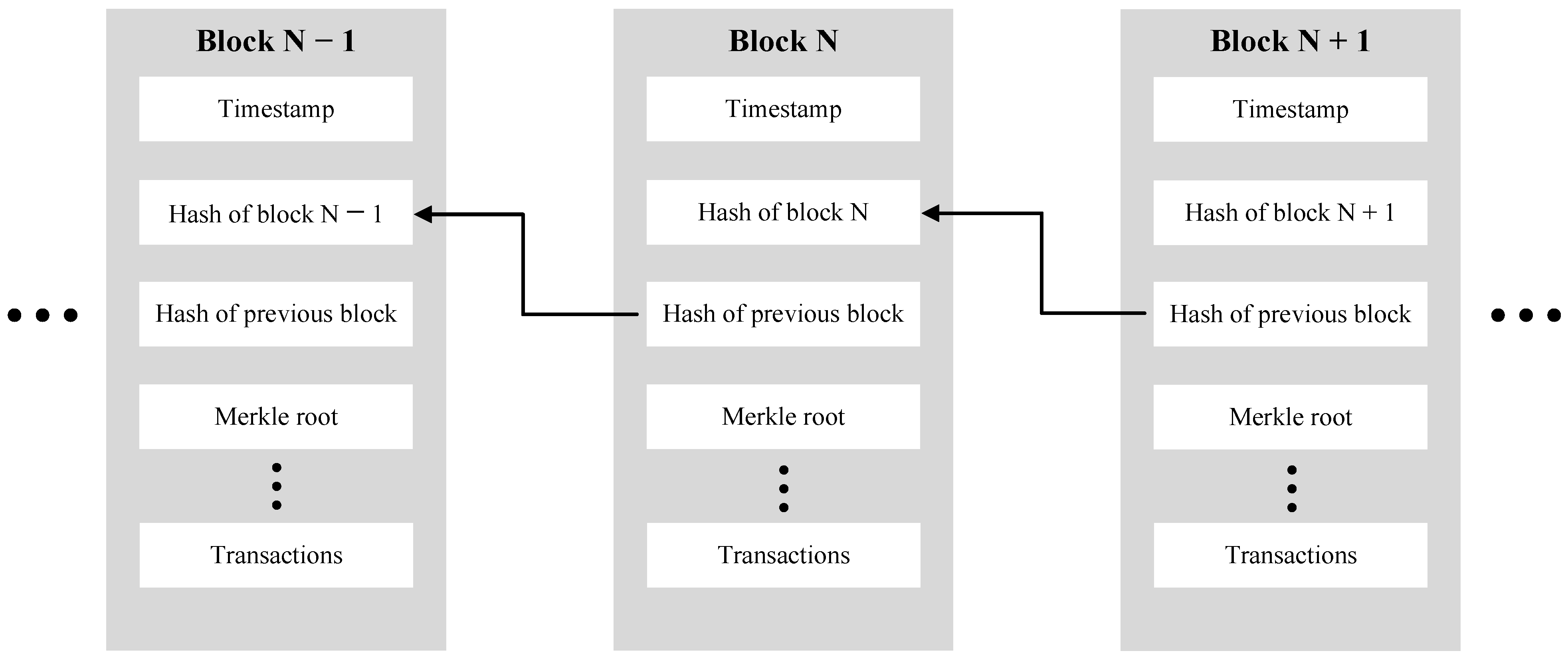
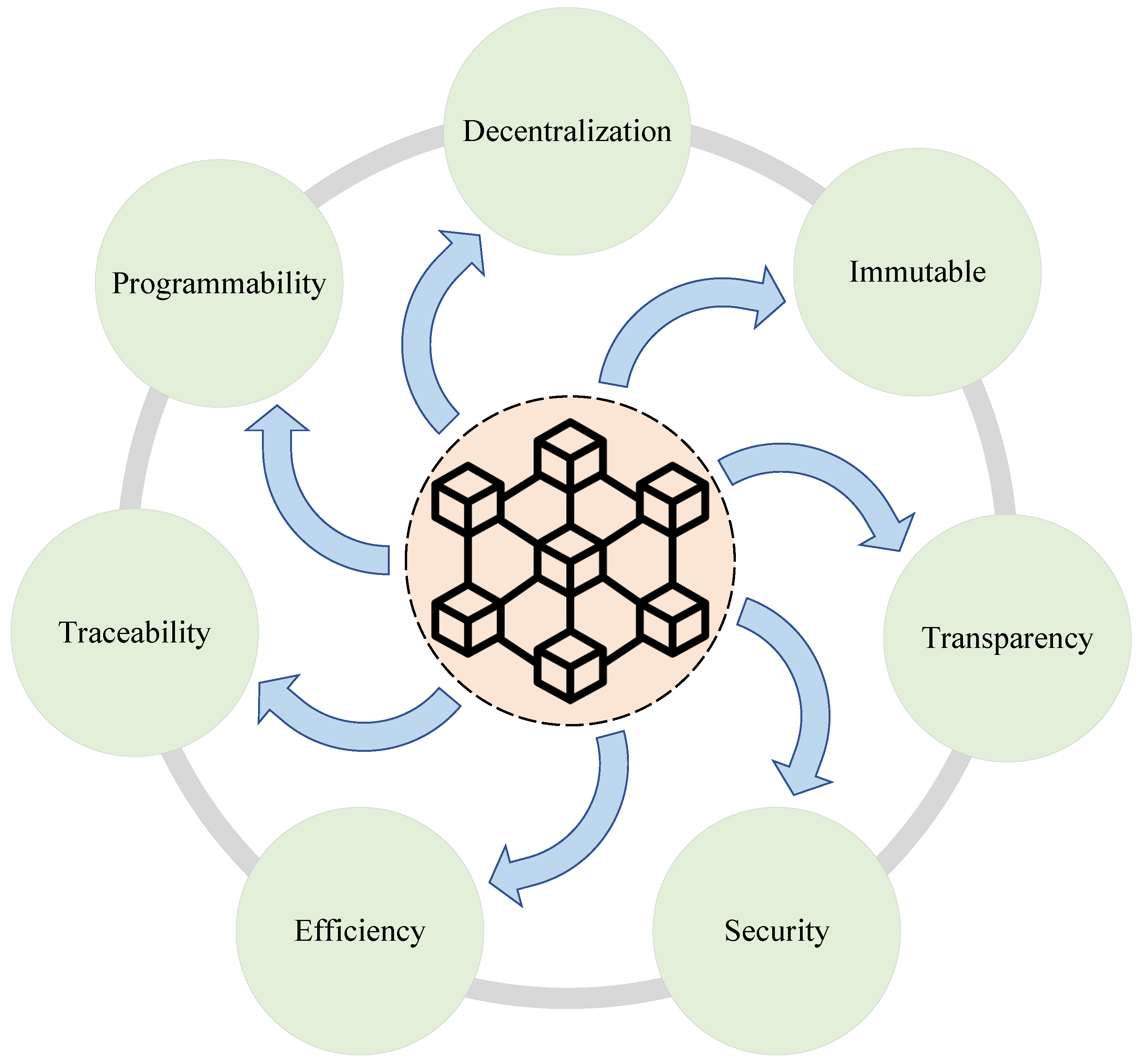
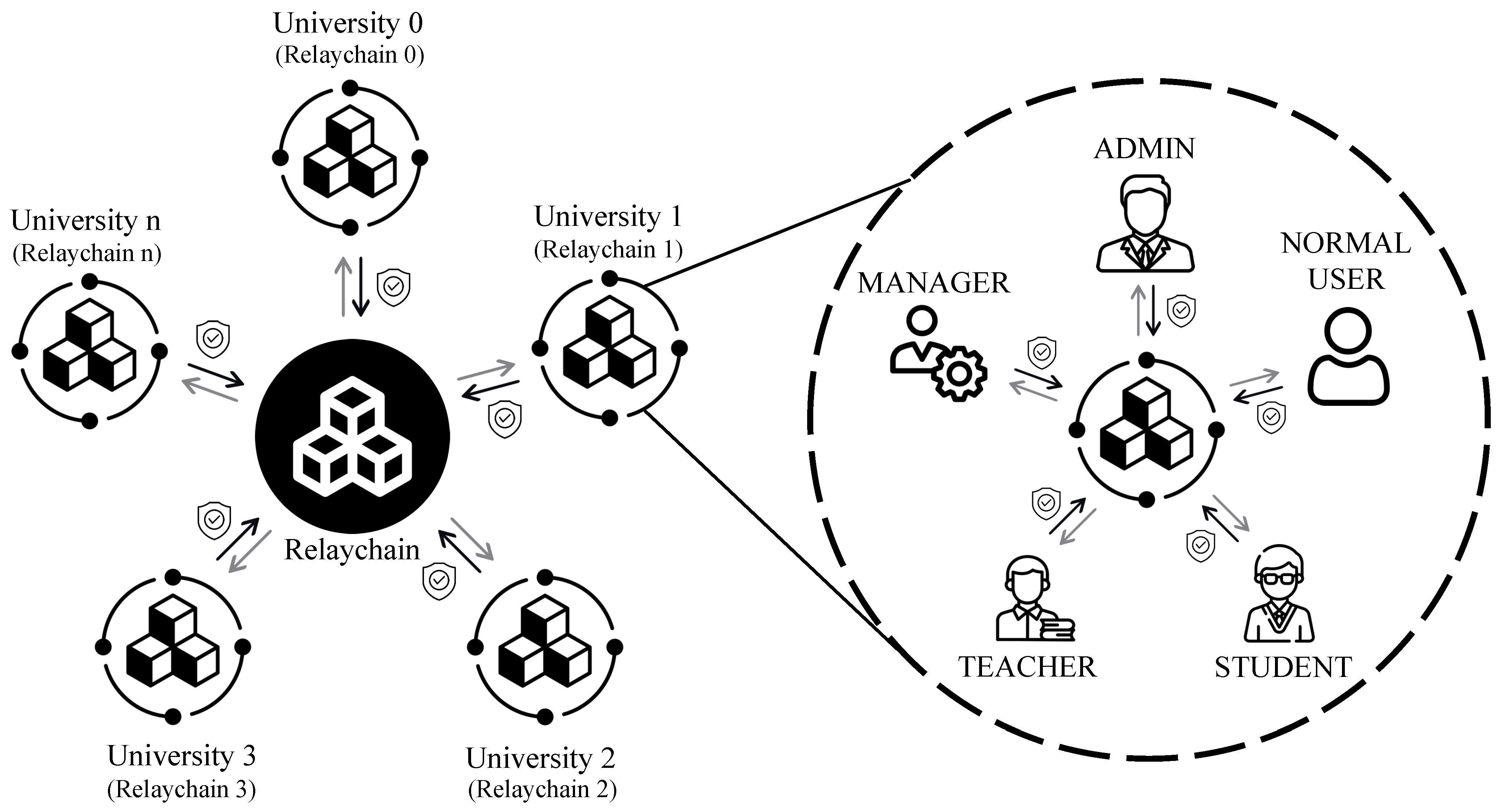
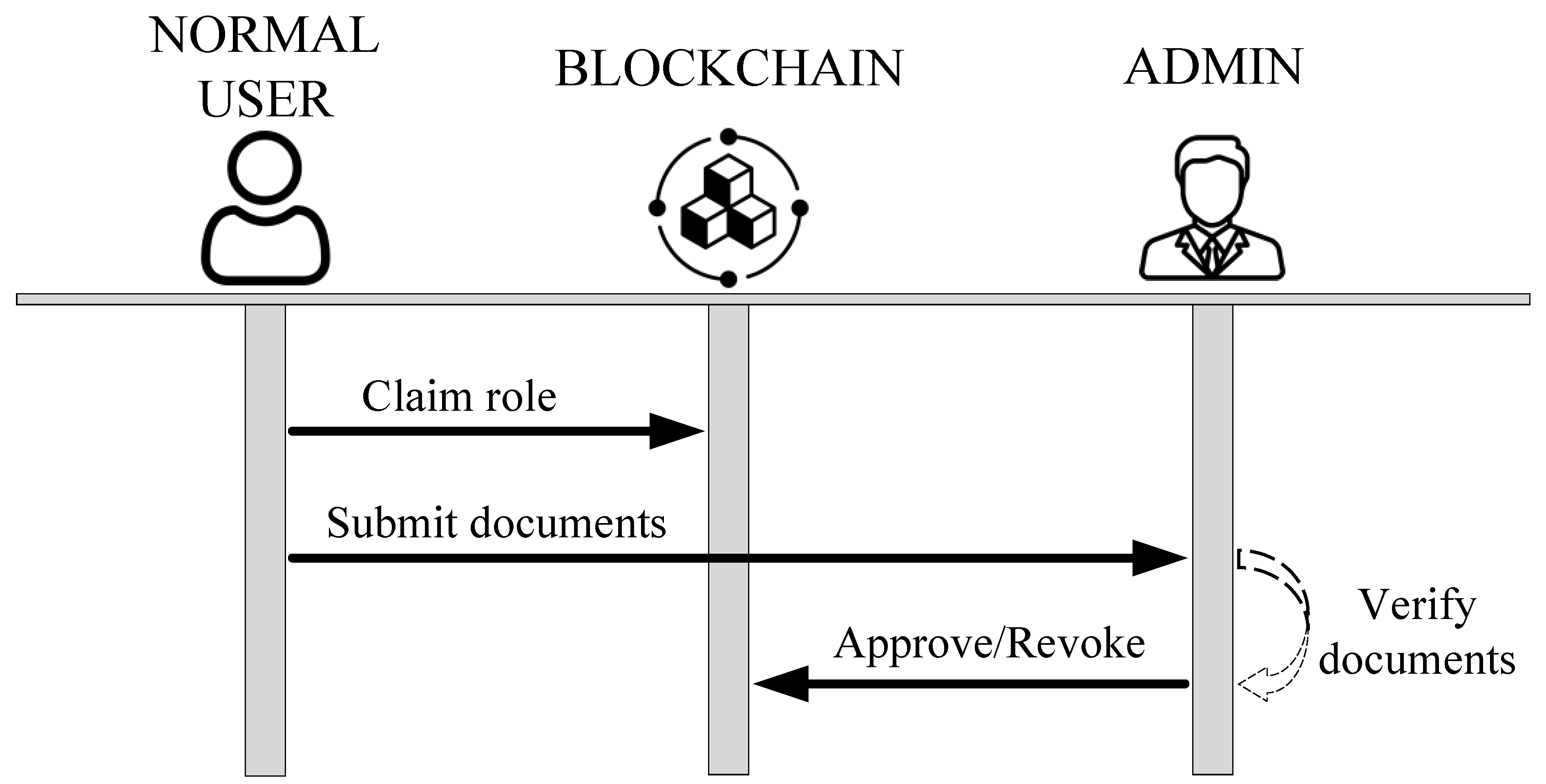
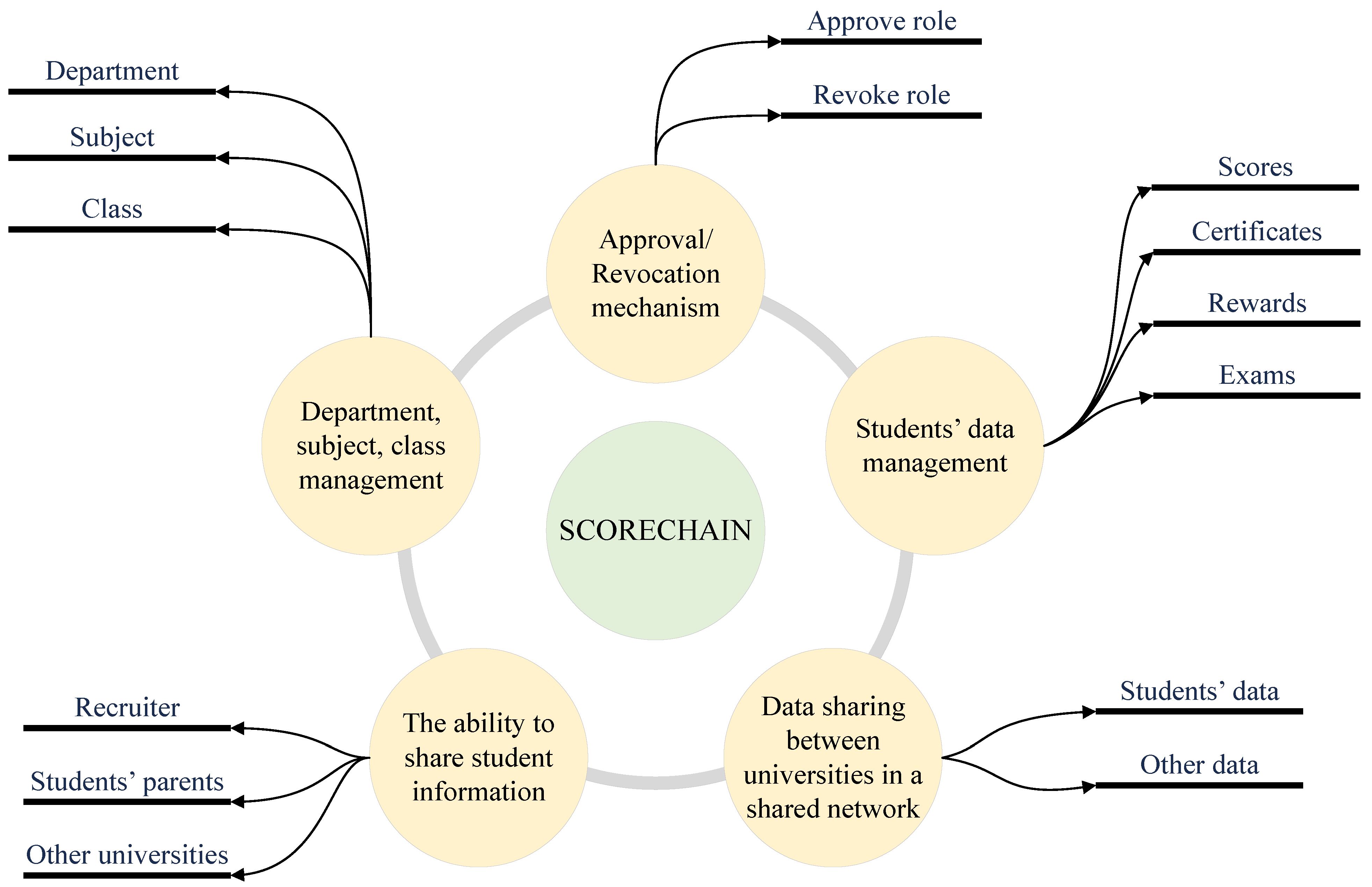
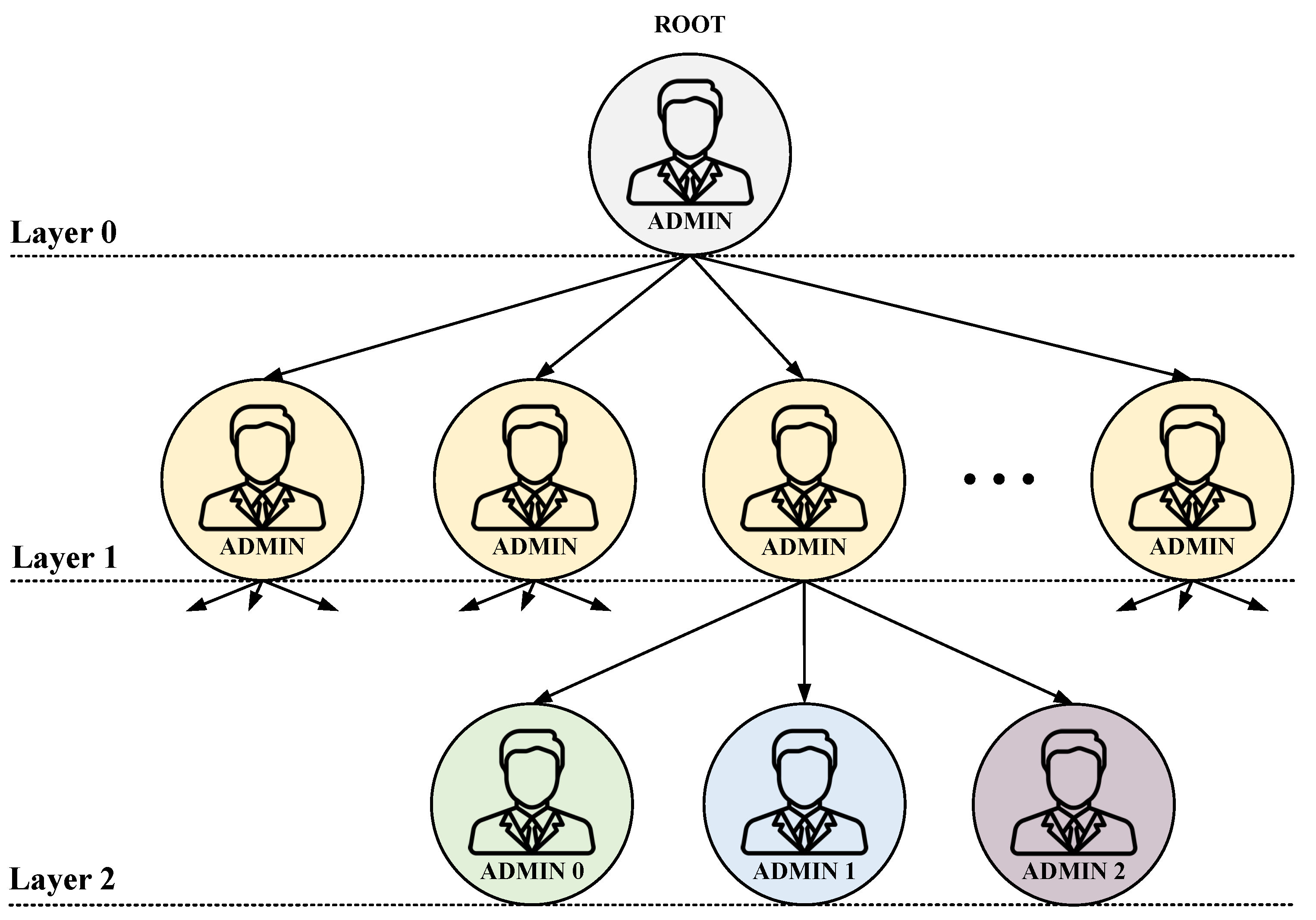
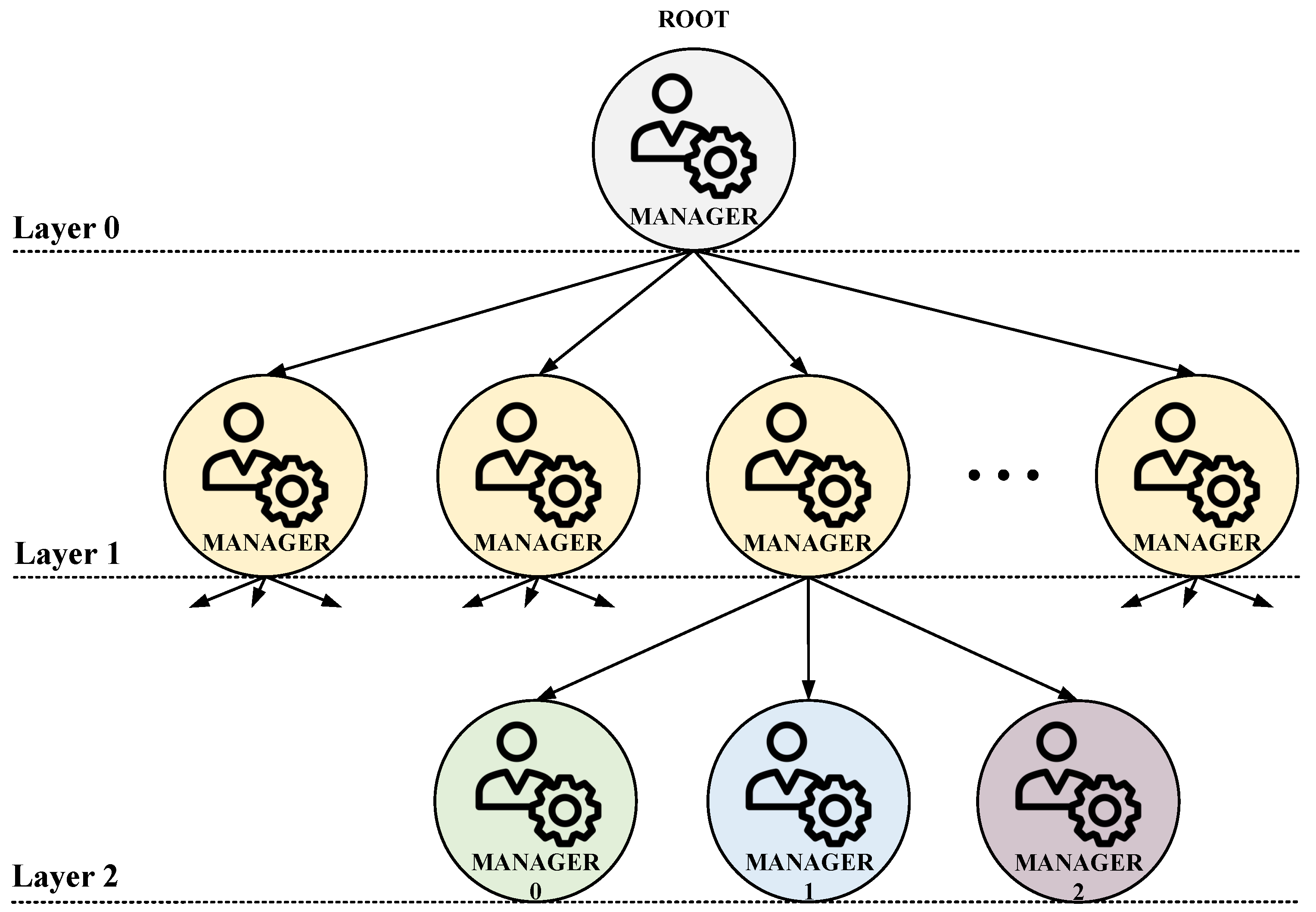
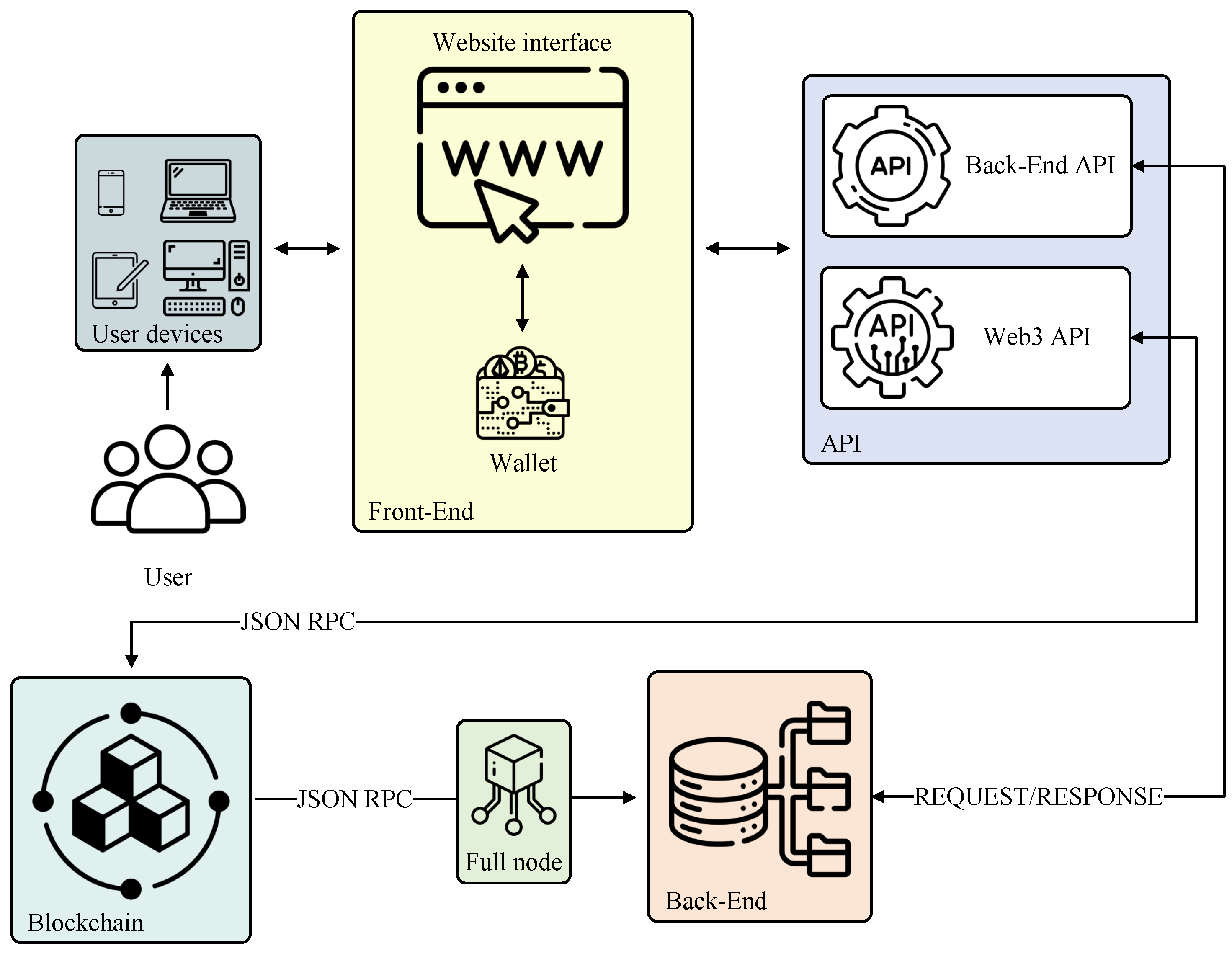
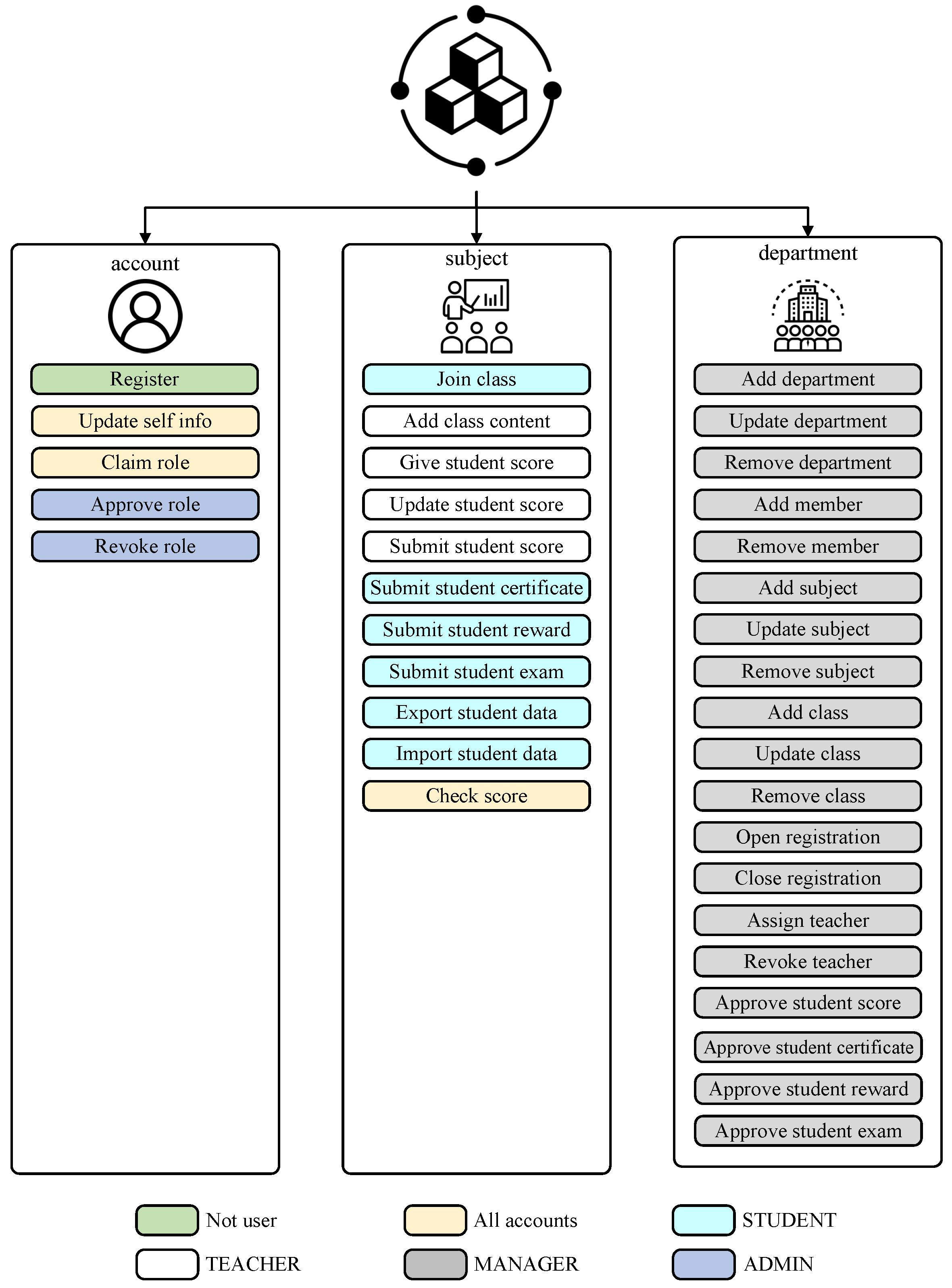
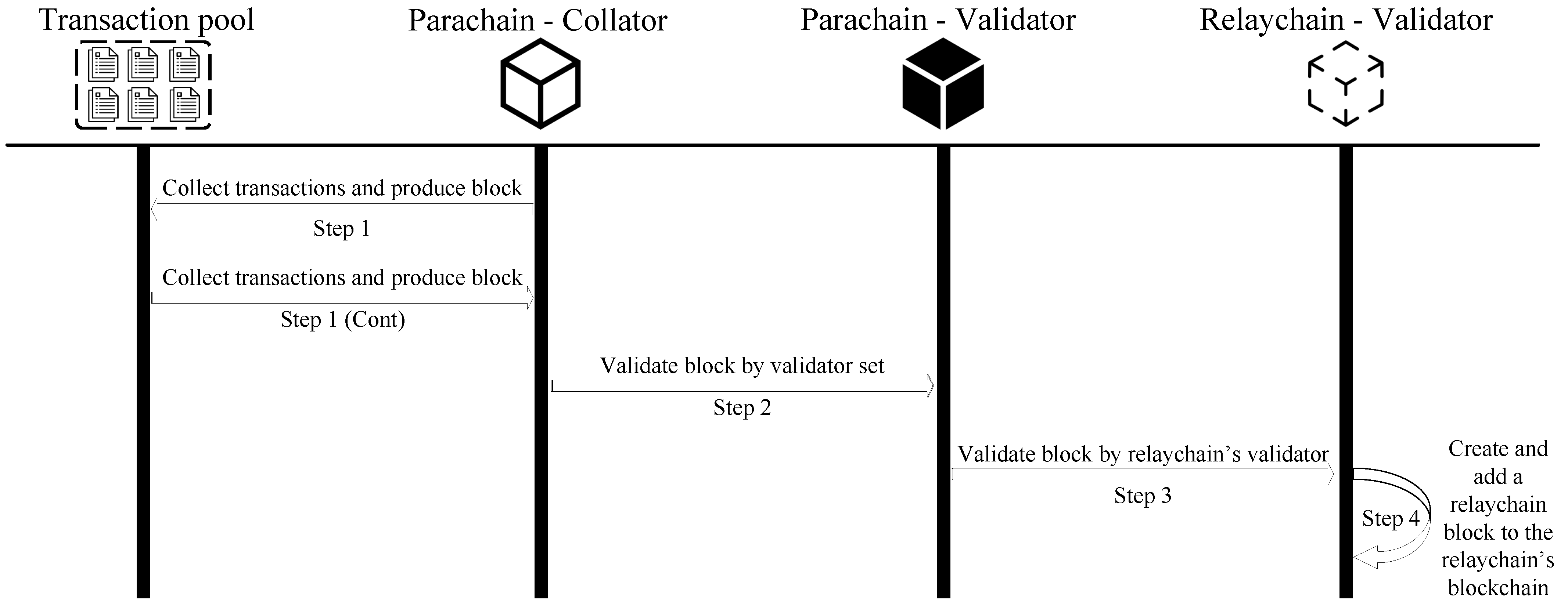
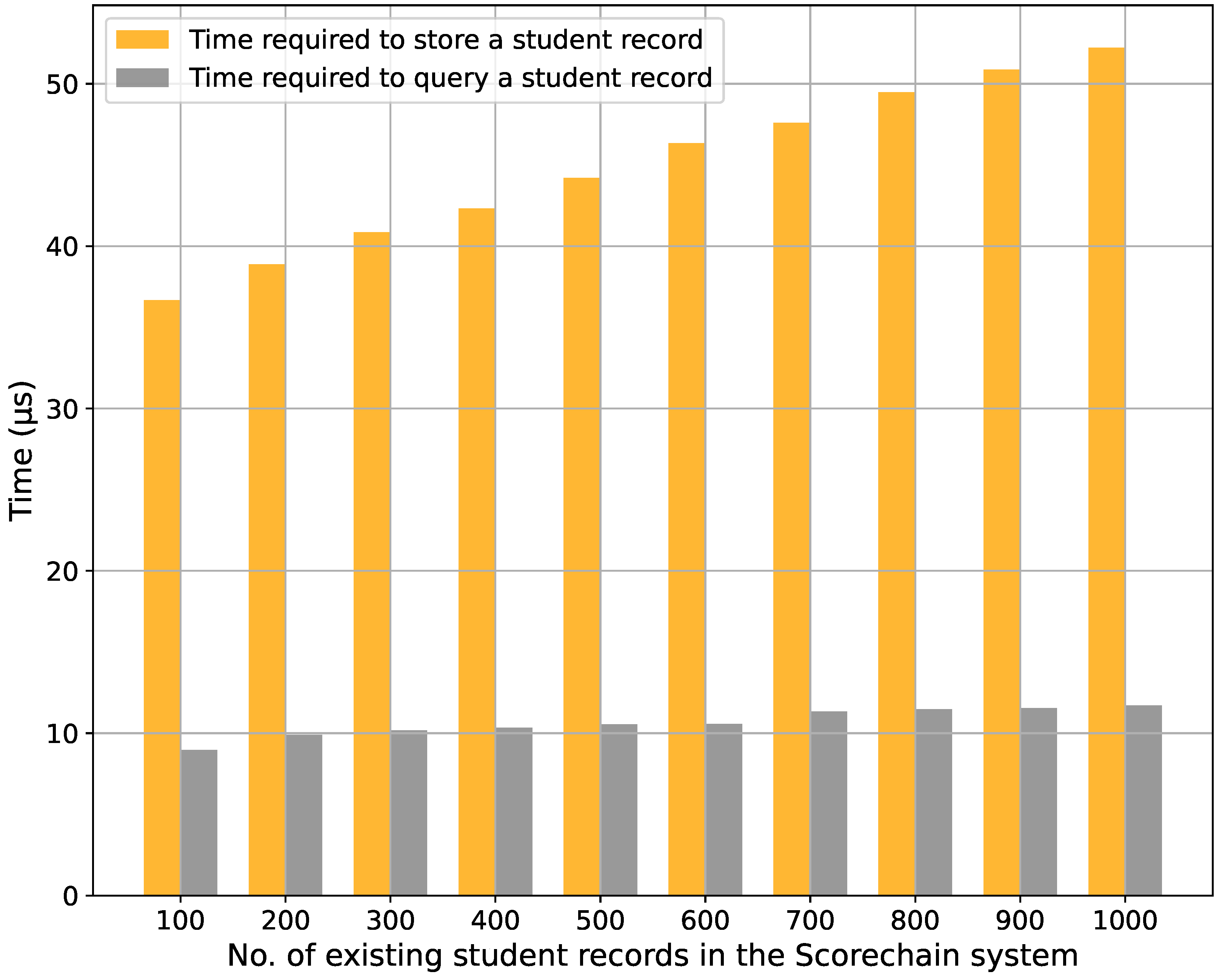
Disclaimer/Publisher’s Note: The statements, opinions and data contained in all publications are solely those of the individual author(s) and contributor(s) and not of MDPI and/or the editor(s). MDPI and/or the editor(s) disclaim responsibility for any injury to people or property resulting from any ideas, methods, instructions or products referred to in the content. |
© 2023 by the authors. Licensee MDPI, Basel, Switzerland. This article is an open access article distributed under the terms and conditions of the Creative Commons Attribution (CC BY) license (https://creativecommons.org/licenses/by/4.0/).
Share and Cite
Tran, V.D.; Ata, S.; Tran, T.H.; Lam, D.K.; Pham, H.L. Blockchain-Powered Education: A Sustainable Approach for Secured and Connected University Systems. Sustainability 2023, 15, 15545. https://doi.org/10.3390/su152115545
Tran VD, Ata S, Tran TH, Lam DK, Pham HL. Blockchain-Powered Education: A Sustainable Approach for Secured and Connected University Systems. Sustainability. 2023; 15(21):15545. https://doi.org/10.3390/su152115545
Chicago/Turabian StyleTran, Van Duy, Shingo Ata, Thi Hong Tran, Duc Khai Lam, and Hoai Luan Pham. 2023. "Blockchain-Powered Education: A Sustainable Approach for Secured and Connected University Systems" Sustainability 15, no. 21: 15545. https://doi.org/10.3390/su152115545
APA StyleTran, V. D., Ata, S., Tran, T. H., Lam, D. K., & Pham, H. L. (2023). Blockchain-Powered Education: A Sustainable Approach for Secured and Connected University Systems. Sustainability, 15(21), 15545. https://doi.org/10.3390/su152115545







